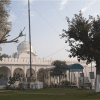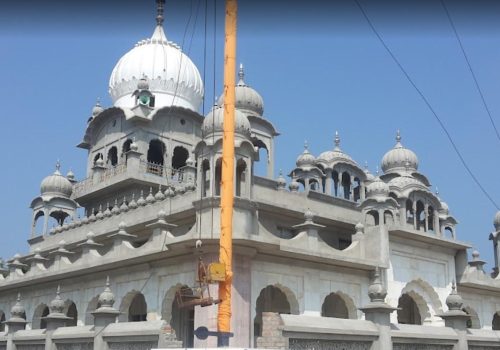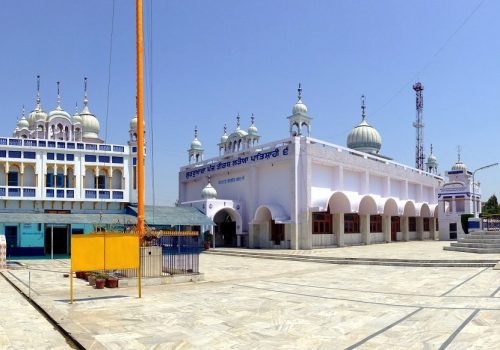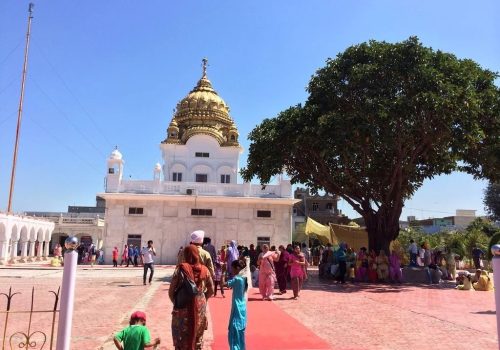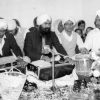KANPUR (26"25`N, 80°17`E), formerly Kanhaiyapur, possesses a Sikh shrine sacred to Guru Tcgh Bahadur. Guru Tegh Bahadur visited the site at the beginning of 1666 while on his way to the eastern parts. The memory of his visit was kept alive by a modest singleroomed shrine which was developed into the present Gurdwara Sri Guru Tcgh Bahadur by Sant Praduman Singh in the early years of the twentieth century. The present building, a multistoreyed modern structure, was completed in 1971. The ground floor serves as a reception hall. In the hall on the first floor, nonstop recital of the Guru Granth Sahib continues simultaneously on several bit`s. The Gurdwara, registered as the Sri Guru Singh Sabha, is administered by a local managing committee.
KAL JHIRANI, village 33 km southwest of Bathinda (30"14`N, 74"59`E), claims an historical shrine, Gurdwara PatshahT Dasviri, commemorating the visit of Guru Gobind Singh in 1706. The present building of the Gurdwara was raised in the early 1970`s. The shrine is managed by the village sangat. Another Gurdwara, 3 km east of the village, was built by Niharigs of the Buddha Dal during the late 1960`s. According to tradition, Guru Gobind Singh had killed a cobra on this site with an arrow.
JHIVAR HERI, a village in Yamunanagar district of Haryana 23 km southwest of Jagadhri (30°10`N, 77″18`E), has a Sikh shrine, Gurdwara Naviri Patshahi, dedicated to...
JASST, also called JassI Bagvali to distinguish it from anotlier village of the same name, is an old village 23 km from Bathinda (30°14`N, 74°59`E). It claims an historical shrine commemorating the visit of Guru Gobind Singh who broke journey here while travelling from Muktsar through Lakkhi Jungle to Talvandl Sabo in 1706. According to legend popularixed by an anonymous and undated old chronicle, Sdkhi Potht, Guru Gobind Singh, on approachingJassi, waded through the village pond on horseback. As he came out at the other bank, the black coat of the horse and the blue robes of the Guru turned white. The pond, since developed into a 70metre square sarovar`w`\ bricklined embankment and steps, is called Baggsar, or the White Tank {baggd in Punjabi means white), and the shrine constructed near its southern bank is known as Gurdwara Sri Baggsar Sahib Patshahi Dasvlri. The Gurdwara is affiliated to the Shiromani Gurdwara Parbandhak Committee, but is managed by Niharigs of the Buddha Dal.
JANDU SINGHA, village 9 km northeast of Jalandhar (31″20`N, 75°35`E) along the JalandharHoshiarpur road, claims a historic shrine, Gurdwara Panj Tirath, commemorating the visit of...
IYALI KALAN, village in Ludhiana district, about 12 km west of the city, is sacred to Guru Hargobind. He passed through this village on his...
GURU MANGAT, a village close to Lahore Cantonment, is sacred to Guru Hargobind (15951644), who visited it during his stay at Muzarig. Gurdwara Patshahi VI,...
DERA BABA NANAK (30° 2`N, 75° 2`E), on the left bank of the River Ravi in Gurdaspur district of the Punjab, is sacred to Guru Nanak, who on the conclusion of one of his long travels arrived here and sat near a well owned by Ajitta Randhava, the chaudhan or headman of Pakkhoke Randhave, village where the Guru`s family had been staying with his wife`s parents. Around the spot where he had halted grew the town of Dera Baba Nanak. As the news of the Guru`s arrival spread, people from the surrounding villages started pouring in everincreasing numbers to see him and receive his blessing. Bhai Ajitta requested him to settle down permanently at or near Pakkhoke. This led to the foundation of a habitation across the Ravi, which the Guru named Kartarpur. On his death, on 7 September 1539, his ashes were buried near Kartarpur and a monument raised over them. But the monument was soon after washed away by a flood in the river. Guru Nanak`s elder son, Baba Sri Chand, who was then staying at Pakkhoke, got the urn containing the ashes salvaged, reburied it close to Ajitta`s well and raised over the spot a mud hut which came to be called Dehra or samadh of Guru Nanak. Later Baba Dharam Das, the sonofGuruNanak`s younger son, Lakhmi Das, founded a new habitation around this Dehra and named it Dera Baba Nanak. There are two historical gurdwaras in the town now. GURDWARA DARBAR SAHIB, in the centre of the town, comprises three separate memorials. The well which originally belonged to Bhai Ajitta Randhava still exists and is reverently called Sarji Sahib. Pilgrims take its water home in the belief that it possesses curative properties. The second memorial is the Kirtan Asthan, a rectangular hall, which marks the site where Guru Arjan had sat rapt in kirtan when visiting Dera Baba Nanak for condolence on the death of Baba Dharam Das. The Guru Granth Sahib is seated in the hall. The central shrine, called Thara Sahib, marks the thara, or platform, on which Guru Nanak had sat when he first came to Ajitta`s well and where, later, Baba Sri Chand buried his father`s ashes. The Guru Granth Sahib is seated here in a small square pavilion with a pinnacled lotus dome under an overhanging gilded canopy. The whole pavilion is covered with goldplated metal sheets with some of the hymns of Guru Nanak embossed on them. The Thara Sahib is at one end of a recently constructed spacious hall, above which, over the sanctum, is a square domed room with an ornamental arched coping and domed kiosks at the corners. The entire exterior above the roof level of this room is covered with goldplated metal sheets. The goldwork on top as well as on the sanctum was got executed in 1827 by Maharaja Ranjit Singh, who also made endowments in cash and land for the maintenance of the shrine. The Gurdwara is administered by the Shiromani Gurdwara Parbandhak Committee through a local committee. Special divans take place on every amavasya, the last day of the dark half of the lunar month, and all major anniversaries, especially the one marking the death of Guru Nanak, are observed. But the most important annual event is the fair celebrating the Baisakhi festival. A handwritten copy of the Guru Granth Sahib is preserved in this Gurdwara. It has 1660 pages, each page having a handsomely illuminated border. GURDWARA LANGAR MANDIR CHOLA SAHIB, in the eastern part of the town, is connected with a relic a chola, or cloak, believed to have been presented to Guru Nanak by a Muslim devotee at Baghdad. The chola, bearing some Qura`nic verses and Arabic numerals, arranged in the form of charms embroidered on it, was procured from Baghdad by Baba Kabali Mall, a descendant of Guru Nanak, it is said. It was brought to Dera Baba Nanak on 20 Phagun 1884 Bk / 1 March 1828. A special shrine was constructed where the Chola Sahib was kept and where it was put on display at the time of a fair held from 21 to 23 Phagun, early March, every year. From the Guru ka Langar which serves the pilgrims, the shrine has come to be known as Gurdwara Langar Mandir Chola Sahib. It was under private management of the resident descendants of Guru Nanak. As the Gurdwara reform movement got under way, the Shiromani Gurdwara Parbandhak Committee claimed possession of the shrine, but the owners resisted. In the end, the control of the Gurdwara passed to the Committee, but Chola Sahib, the relic, remained with the family. It is now displayed in a glass case in a private house, about 50 metres from the Gurdwara, attended in rotation by three Bedi families living there. Gurdwara Langar Mandir Chola Sahib is now administered by the local committee managing Gurdwara Darbar Sahib. The 3day annual fair and Guru ka Langar are held as usual in the adjoining compound. The Gurdwara compound also has within it the samadh of Baba Kabali Mall and an octagonshaped old well. The local belief is that the water of this well cures women whose offspring die during infancy.
BHUNDAR, village 7 km south of Rampura Phul (30° 16`N, 75° 14`E) in Bathinda district of the Punjab, claims a historical shrine, Gurdwara Sahib Chhevin Patshahi, commemorating the visit of Guru Hargobind in 1634. The Gurdwara, situated on the northern edge of the village, comprises an old domed structure and a divan hall added during the late 1950`s. The old shrine has only a square platform on which a few weapons are displayed. The Guru Granth Sahib is seated in the sanctum within the hall marked off by rectangular pillars with decorative pilasters and pfpaJleaf arches. The Gurdwara is maintained by the village sangat or community.
AJRANA KALAN, village in Kurukshetra district of Haryana, 12 km southwest of Shahabad (30°lb`N, 76°53`E), is sacred to Guru Tegh Bahadur who stopped here in 1670 while on his way from Delhi to join his family at Lakhnaur. A Manji Sahib established to commemorate the visit of the Guru exists on the southern side of the village. It consists of a small octagonal domed structure, built on a wider base. The Gurdwara is administered privately by a Sikh family of the village. A civil suit for the control of the shrine is going on between this family and the Shiromani Gurdwara Parbandhak Committee as represented by the Gurdwara Committee of Shahabad.
